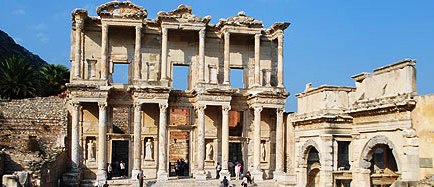
Evocative Ephesus
Karen Britt
Each time I visit Ephesus, I am surrounded by people: those visiting the spectacular site today and those who lived in this bustling metropolis centuries ago. Undoubtedly, a vivid imagination—something I have had since childhood—led me to archaeology. As a young girl and later, as a teen, I read a lot and almost exclusively books about people who lived in the past (think: Louisa May Alcott, Charles Dickens, Laura Ingalls Wilder and biographies for kids). Consequently, the people who lived in the past were real to me, so real that I thought of them as my friends and their enemies were mine. Although older, the past remains real to me; historical figures still seem like friends and enemies except now they sometimes switch sides! As an archaeologist, I am fortunate to be able to dwell in and on the past a good deal of the time and to have acquired the tools necessary to reconstruct past cultures.

Smithsonian Travelers at Ephesus, Turkey. Photo: Karen Britt.
As a specialist in Late Antique and Byzantine archaeology, when I walk through the streets of Ephesus today, it is not difficult to envision the past: it is a remarkably well-preserved site. As I stroll down the colonnaded Curetes Street with its mosaic-paved sidewalks, I enjoy the breezes from the harbor and imagine the cooling sounds of water splashing in fountains (nymphaea) adjacent to the street. I can picture the upper and lower markets (agoras) full of shoppers bargaining for supplies with vendors. When I close my eyes, against a backdrop of temples, mansions, the Library of Celsus and countless public statues, I see men moving along bustling streets as they make their way to the theater and women rushing to take advantage of their limited hours in the baths.
Walking toward the Double Church of the Virgin, I am transported back to the important ecumenical Church Council of 431 that occurred here. I envision robed bishops, from near and far, heatedly debating, for months, the nature of Christ. Was he truly man and truly God simultaneously? And if so, how should the Virgin Mary’s relationship to Christ be defined? Weighty matters, indeed, were decided in this place, matters of enormous consequence for the future development of the Church.
On a glorious spring morning, as I sit on a fallen column in the atrium of the church and gaze toward the well-preserved apse of the sanctuary, I cannot imagine ever tiring of Ephesus. Each and every time I visit, the stones speak to me.
If you're ready to see Ephesus for yourself, click for more on our Legendary Turkey and the Turquoise Coast tour. Karen Britt will be traveling with you next to Anatolia, and click here for more information on this tour.


/https://tf-cmsv2-journeys-media.s3.amazonaws.com/journeys/catalog/cover_image/Mar_24_SJ_Cover.jpg)
 Be the First to Know
Be the First to Know